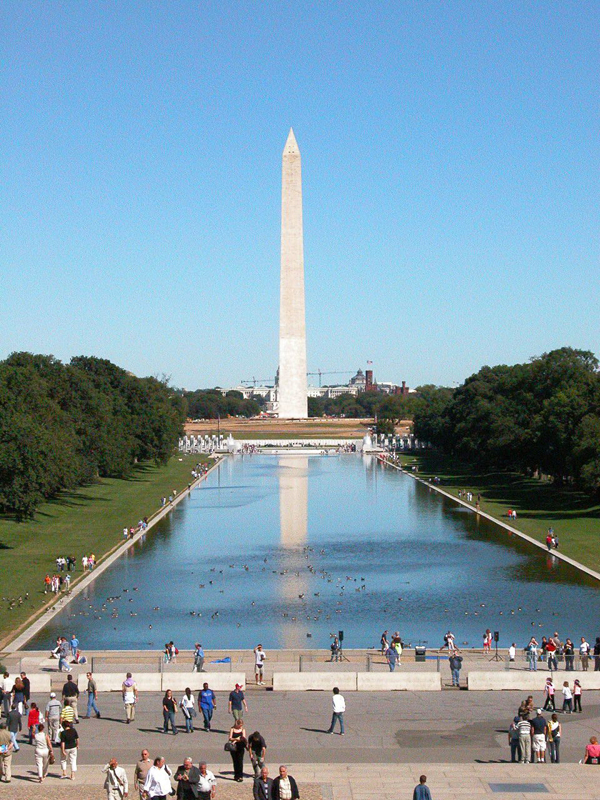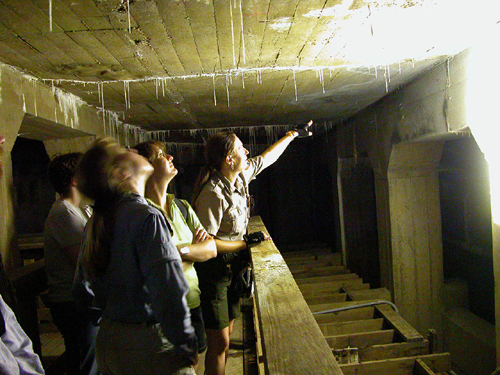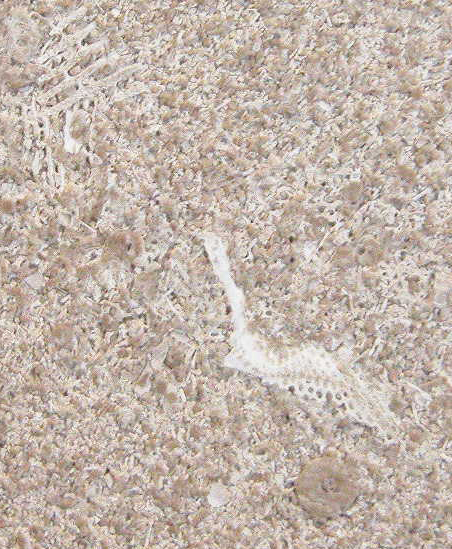Geotimes

Untitled Document

Travels in Geology
October 2004, Web Extra October 15, 2004
 Pedaling
D.C.'s monuments
Pedaling
D.C.'s monuments
With Earth Science Week in progress and the presidential
elections less than three weeks away, this is the perfect time to connect with
both the planet and our nation's history. Every Saturday and Sunday, a bicycle
tour leaves at 1:00 p.m. from the Jefferson Memorial to explore the Mall's lesser
known natural and cultural history, and this Sunday, the topic is geology.
When the national monuments bike tour, organized by the National Park Service,
is on the geology of the Mall, Ranger Sonya Berger leads the three-hour trek,
covering most of the main monuments and a few unofficial stops as well.
The tour starts with a ride out to Hains Point to delve into the geography
of Washington, D.C., and the geologic history of the region. You'll learn how
the placement of Washington, D.C., was largely controlled by the morphology
of the Potomac River and what factors went into George Washington's decision
to pick the present spot for the capital. Many of the most important buildings
were built up high to protect from flooding, including the White House, which
rests upon an old river terrace.
From the steps of the Lincoln Memorial, the Washington Monument stands out prominently.
The color change one-quarter of the way up the monument is due to a change in
quarry locations. During a pause in construction in the mid-1800s, the quarry
near Baltimore supplying the marble ran out of rock. The top of the monument
was built from marble from another nearby quarry. The new World War II Memorial
is visible at the far end of the reflecting pool. All
photographs courtesy of Jay Chapman.
Berger is able to concisely articulate many geologic principles in an easy to
understand way and uses examples to help visitors understand fundamental concepts.
The tour usually contains three to 15 people and the leisurely pace makes it
easy to ride along and chat or ask questions.
 The next stop is the Franklin
Delano Roosevelt Memorial. Berger explains that because Roosevelt was an advocate
for the common man, the monument is made out of a common, unassuming rock —
rough-hewn granite. The memorial was built on a human scale and rarely exceeds
20 feet in height. As you walk through the memorial, which follows the events
of Roosevelt's presidency, the granite subtly changes. For example, the section
on World War II contains large jumbled pieces of broken granite, reminiscent
of the widespread destruction in Europe. Some of Berger's geologic connections
— such as an interlocking granitic texture representing national unity
— are tenuous, but are still fun to entertain.
The next stop is the Franklin
Delano Roosevelt Memorial. Berger explains that because Roosevelt was an advocate
for the common man, the monument is made out of a common, unassuming rock —
rough-hewn granite. The memorial was built on a human scale and rarely exceeds
20 feet in height. As you walk through the memorial, which follows the events
of Roosevelt's presidency, the granite subtly changes. For example, the section
on World War II contains large jumbled pieces of broken granite, reminiscent
of the widespread destruction in Europe. Some of Berger's geologic connections
— such as an interlocking granitic texture representing national unity
— are tenuous, but are still fun to entertain.
National Park Service Ranger Sonya Berger
points out an interesting stalactite in the foundation room of the Lincoln Memorial.
Water seeping through cement in the memorial's steps above picks up minerals
and deposits them here. The foundation room is not open to the public and is
not an official stop on every tour.
The bicycle tour continues on, briefly looking at the Korean and Vietnam War
memorials, both of which feature a highly polished, greenish-black gabbro to
fit the somber mood.
The Lincoln Memorial is one of the high points of the bicycle tour. The monument
contains igneous, metamorphic and sedimentary rocks from all across the country
— limestone from Indiana, granite from Massachusetts, and marble from Colorado,
Tennessee, Georgia and Alabama. The broad geographical provenance of the rocks
symbolizes Lincoln's preservation of the Union by bringing together resources
from the North, South, East and West.
 The 250-million-year-old
Indiana limestone, comprising the interior columns and walls at the Lincoln
Memorial, is full of shallow marine fossils, including crinoids and bryozoans.
Berger points out where some of the best fossils are and happily shoos away
other tourists to get to them. She says the reflecting pool at the Capitol building
is really the best spot to view the fossiliferous Indiana limestone.
The 250-million-year-old
Indiana limestone, comprising the interior columns and walls at the Lincoln
Memorial, is full of shallow marine fossils, including crinoids and bryozoans.
Berger points out where some of the best fossils are and happily shoos away
other tourists to get to them. She says the reflecting pool at the Capitol building
is really the best spot to view the fossiliferous Indiana limestone.
If you are lucky, Berger may be able to include an unofficial look into the
foundation of the Lincoln Memorial, where "petroglyphs" from the 1920s
are enscribed into the walls, and calcite stalactites hang from the ceiling.
Water seeping in from the memorial above dissolves calcium in the cement, which
reforms as stalactites and stalagmites in the foundation room.
This closeup photo of the Indiana limestone
in the Lincoln Memorial shows several bryozoans (looks like netting or mesh)
and a crinoid stem (round object in the lower right).
Back in daylight, you can stand in the footsteps of Martin Luther King Jr.
and look out from the Lincoln Memorial steps across the reflecting pool to the
Washington Monument. Because the monument is currently undergoing security enhancements,
access is limited, but Berger still has a few things to point out. Inside the
monument, rocks from all 50 states are incorporated into the interior walls,
including green jade from Alaska, copper from Michigan and pipestone from Minnesota.
The prominent line, one-third of the way up the Washington Monument represents
a change in marble, when the local quarry supplying the stone ran out during
a hiatus in construction. Unlike more modern monuments, which feature rocks
from across the country, this monument only contains rocks quarried on the East
Coast. Transportation was limited to waterways in the mid-1800s when the monument
was being built.
The tour concludes with a few other low-profile stops that really round out
the geologic underpinnings of the nation's capital. Scheduled bicycle tours
stop during the coldest winter months, but can easily be arranged by contacting
Berger. The tours are free, open to the public and BYOB
— bring your own bike. Bicycle rentals are available
in town. If you cannot make it to Washington, but are still interested in the
tour, there is a comprehensive Web site and brochure
about the geology of the monuments on the National Park Service Web site.
Jay Chapman
Geotimes intern
Links:
sonya_berger@nps.gov
Geology
of the National Mall National Park Service
Geology
of the memorials brochure National Park Service
The
National Mall National Park Service
Building
stones of our nation's capital USGS
Bicycle
rentals in Washington, D.C. bikewashington.org
This
is Earth Science Week
This week, Oct. 10 to Oct. 16, is Earth Science Week, organized by the American
Geological Institute. It is a time for earth scientists and educators to help
the public gain a better understanding and appreciation for the earth sciences
and to encourage stewardship of the planet. In a year when four hurricanes have
struck the Southeast, Mount St. Helens has rumbled to life in Washington, lava
from Kilauea has continued plunging into the sea in Hawaii, and places around
the world have experienced earthquakes, including a magnitude-7.0 temblor that
shook Taiwan overnight, it seems fitting that this year's Earth Science Week
is themed Living on a Restless Earth.
Earth Science Week activities have occurred in all 50 states and around the
world this week, such as fossil collecting at the Hamberg Natural History Society
in Buffalo, N.Y., an earthquake activity day in Pasadena, Calif., and a field
trip to the Shenandoah National Park in Virginia, in addition to many museum
and geological survey open houses and activities. Whether people participate
in geoscience-sponsored events or simply take a nature walk, this is a good
week to notice the wonders of Earth.
Visitors to the nation's capital have another option this week, and many other
weeks throughout the year as well: They can take the bike tour
of the geology of the national monuments, led by national park staff, as
discussed above. The next ride will be this Sunday, Oct. 17, at 1 p.m.
Link:
Earth
Science Week
Back to top
Untitled Document

 The next stop is the Franklin
Delano Roosevelt Memorial. Berger explains that because Roosevelt was an advocate
for the common man, the monument is made out of a common, unassuming rock —
rough-hewn granite. The memorial was built on a human scale and rarely exceeds
20 feet in height. As you walk through the memorial, which follows the events
of Roosevelt's presidency, the granite subtly changes. For example, the section
on World War II contains large jumbled pieces of broken granite, reminiscent
of the widespread destruction in Europe. Some of Berger's geologic connections
— such as an interlocking granitic texture representing national unity
— are tenuous, but are still fun to entertain.
The next stop is the Franklin
Delano Roosevelt Memorial. Berger explains that because Roosevelt was an advocate
for the common man, the monument is made out of a common, unassuming rock —
rough-hewn granite. The memorial was built on a human scale and rarely exceeds
20 feet in height. As you walk through the memorial, which follows the events
of Roosevelt's presidency, the granite subtly changes. For example, the section
on World War II contains large jumbled pieces of broken granite, reminiscent
of the widespread destruction in Europe. Some of Berger's geologic connections
— such as an interlocking granitic texture representing national unity
— are tenuous, but are still fun to entertain.
 Pedaling
D.C.'s monuments
Pedaling
D.C.'s monuments
 The 250-million-year-old
Indiana limestone, comprising the interior columns and walls at the Lincoln
Memorial, is full of shallow marine fossils, including crinoids and bryozoans.
Berger points out where some of the best fossils are and happily shoos away
other tourists to get to them. She says the reflecting pool at the Capitol building
is really the best spot to view the fossiliferous Indiana limestone.
The 250-million-year-old
Indiana limestone, comprising the interior columns and walls at the Lincoln
Memorial, is full of shallow marine fossils, including crinoids and bryozoans.
Berger points out where some of the best fossils are and happily shoos away
other tourists to get to them. She says the reflecting pool at the Capitol building
is really the best spot to view the fossiliferous Indiana limestone.